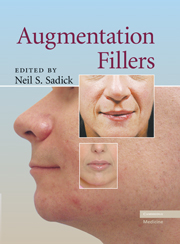Book contents
- Frontmatter
- Contents
- LIST OF CONTRIBUTORS
- Ch. 1 Application of Fillers
- Ch. 2 Approach to Choosing the Ideal Filler
- Ch. 3 Patient Selection, Counseling, and Informed Consent
- Ch. 4 Hyaluronic Acid Skin Derivatives
- Ch. 5 Collagen Products
- Ch. 6 Radiesse
- Ch. 7 ArteFill
- Ch. 8 Augmentation Fillers in Cosmetic Dermatology: Silicone
- Ch. 9 Advanta Expanded Polytetrafluoroethylene Implants
- Ch. 10 Sculptra
- Ch. 11 Lipo Transfer
- Ch. 12 BioAlcamid®
- Ch. 13 Combination of Approaches in Augmentation Fillers in Cosmetic Dermatology
- Ch. 14 Filling Complications
- Ch. 15 Postprocedure Management and Patient Instructions
- Ch. 16 Conclusion: Future Trends in Fillers
- INDEX
- References
Ch. 1 - Application of Fillers
Published online by Cambridge University Press: 26 February 2010
- Frontmatter
- Contents
- LIST OF CONTRIBUTORS
- Ch. 1 Application of Fillers
- Ch. 2 Approach to Choosing the Ideal Filler
- Ch. 3 Patient Selection, Counseling, and Informed Consent
- Ch. 4 Hyaluronic Acid Skin Derivatives
- Ch. 5 Collagen Products
- Ch. 6 Radiesse
- Ch. 7 ArteFill
- Ch. 8 Augmentation Fillers in Cosmetic Dermatology: Silicone
- Ch. 9 Advanta Expanded Polytetrafluoroethylene Implants
- Ch. 10 Sculptra
- Ch. 11 Lipo Transfer
- Ch. 12 BioAlcamid®
- Ch. 13 Combination of Approaches in Augmentation Fillers in Cosmetic Dermatology
- Ch. 14 Filling Complications
- Ch. 15 Postprocedure Management and Patient Instructions
- Ch. 16 Conclusion: Future Trends in Fillers
- INDEX
- References
Summary
INTRODUCTION
In the last five years, there has been an increased demand in the number of fillers available in the market. This corresponds with the increased demand for less-invasive procedures among consumers. The result is a wide array of choices for the patient and injector to address almost any type of problem. In this chapter, we outline the various applications of fillers throughout the body.
BACKGROUND
The ideal injectable filler remains elusive to this day. The properties we look for in an ideal injectable filler include safety, ease of use, consistency of results, and longevity of results.
Liquid silicone was the first filler available to treat contour defects, scars, and rhytids of the face. It was widely used for two decades until concerns about long-term safety caused it to fall out of favor. Several years ago, a new liquid silicone product was cleared by the FDA and has been used in an “off-label” fashion for cosmetic enhancement of the face. Liquid silicone is a permanent filler.
Bovine collagen was the second available injectable filler and was widely used with a very low incidence of complications. Allergy testing of the skin was necessary with Zyderm and Zyplast. These products lasted for a few months after injection, requiring frequent administration. Over the years, collagen-based products have evolved. Cosmoderm and Cosmoplast (human collagen) eliminated the need for skin testing. Evolence (porcine collagen) is cross-linked, giving it a longer-lasting quality, and it does not require skin testing.
Autologous fat transfer techniques were introduced around the same time as bovine collagen.
- Type
- Chapter
- Information
- Augmentation Fillers , pp. 1 - 4Publisher: Cambridge University PressPrint publication year: 2010



